Do you want to know how paintball guns work? In this article, we will provide a comprehensive guide to understanding the inner workings of these firearms. We’ll answer some common questions about paintball guns and offer tips for getting started in the sport. Keep reading to learn more about how these guns operate, whether you’re a beginner or an experienced player!
What Is a Pump Paintball Gun?
They are considered more challenging to use, but they offer a number of advantages, such as increased accuracy and efficiency.
Pump paintball guns were some of the first markers created specifically for the sport of paintball. Early versions were little more than modified air pistols or BB guns, which made them notoriously unreliable. Modern pump guns have come a long way since then, and while they may not be as popular as semi-automatic markers, they’re still used by a large number of players.
Because each shot must be manually cocked, there is less opportunity for paintballs to become jostled or jarred in the marker. This can lead to more consistent shots and improved accuracy, especially at long range. Additionally, pump guns are often more efficient than their semi-automatic counterparts. [1]

If you’re interested in trying out a pump gun, it’s important to remember that they require a bit more skill and practice to use effectively. Most pump players will tell you that the added challenge is part of the appeal, but it’s something to keep in mind before making your purchase. With a little practice, you’ll be pumping out shots with the best of them in no time!
The Paintball Gun: The Basics
Paintball guns are powered by either compressed air or CO₂, and can vary significantly in size, shape, and performance.
Paintballs are typically made of a non-toxic, biodegradable polymer shell filled with a water-soluble dye. The fill material is under pressure from the time it is loaded into the gun until it impacts its target; upon impact, the shell ruptures and the fill material splatters over the target surface. This “marking” of the target is how players are eliminated in the game of paintball.
There are many different types of paintball guns on the market, from simple pump-action markers to high-end electronic markers that can cost hundreds of dollars. Choosing the right gun for you is a matter of personal preference and playing style.
Paintball guns typically fall into one of three categories: pump-action, semi-automatic, or fully automatic. Pump-action markers require the player to manually cock the gun before each shot, while semi-automatic and fully automatic markers will do this automatically. Fully automatic markers are generally not allowed in most recreational paintball games as they give players a significant advantage over those using other marker types.
When shopping for a paintball gun, it is important to consider what type of paintball you will be playing. Woodsball is a style of play that takes place in natural environments such as forests or fields, while speedball is played on man-made courses designed for fast-paced action. Each type of play requires different equipment, and it is important to choose a marker that is well-suited to the type of game you plan to play.
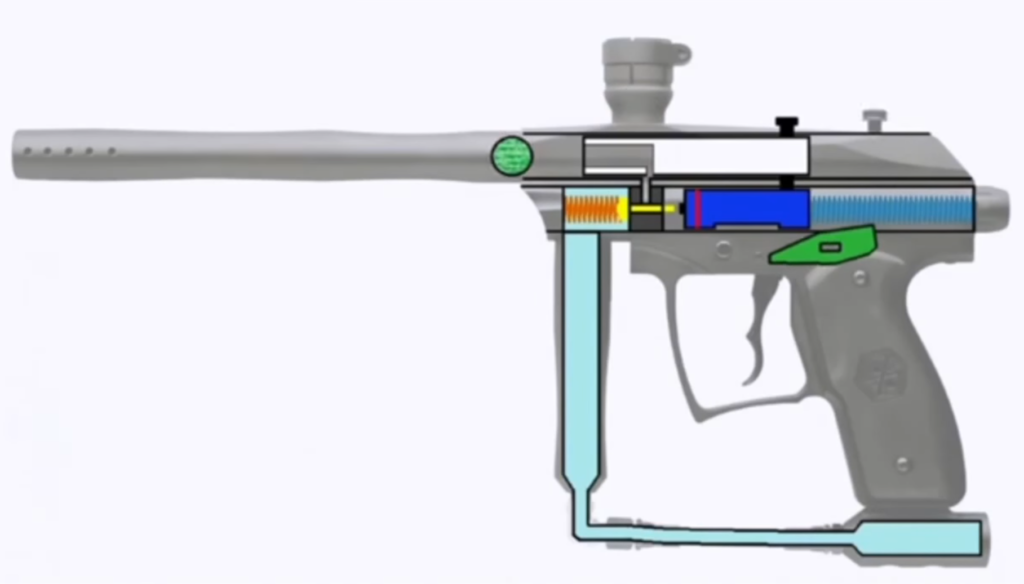
Compressed air tanks are typically filled to 3000 PSI, while CO₂ tanks can be filled to much higher pressures. CO₂ is generally considered more reliable than compressed air, but is also more expensive to operate. [2]
When choosing a paintball gun, it is important to consider your budget and your playing style. There are many different types of markers on the market, from simple pump-action guns to high-end electronic markers.
The Feeder
The feeder system is what loads the paintballs into the gun. There are two primary types of feeders: gravity fed and hopper fed.
Gravity fed systems rely on gravity to pull the paintballs from a storage container (usually a bag or box) into the gun. These systems are typically cheaper and more reliable than hopper fed systems, but they can be slower to load and may require the player to stop shooting periodically to reload the storage container.
Hopper fed systems use a motorized device (the “hopper”) to load paintballs into the gun from a storage container. Hoppers can hold hundreds of paintballs, making them ideal for rapid-fire play. However, they can be more expensive than gravity fed systems and may require more maintenance.
When choosing a feeder system, it is important to consider the type of paintball you will be playing. If you plan on playing a lot of rapid-fire games, a hopper fed system may be a better option for you. If you are planning on playing mostly woodsball or scenario games, a gravity fed system may be a better option.
Paintball guns typically fall into one of three categories: pump-action, semi-automatic, or fully automatic. Pump-action markers require the player to manually cock the gun before each shot, while semi-automatic and fully automatic markers will do this automatically. Fully automatic markers are generally not allowed in most recreational paintball games as they give players a significant advantage over those using other marker types.
The Chamber
The chamber is the part of the paintball gun that holds the paintball before it is fired. Most chambers are made of metal or plastic and are designed to hold a single paintball. Some chambers are transparent, allowing the player to see if there is a paintball in the gun before firing.
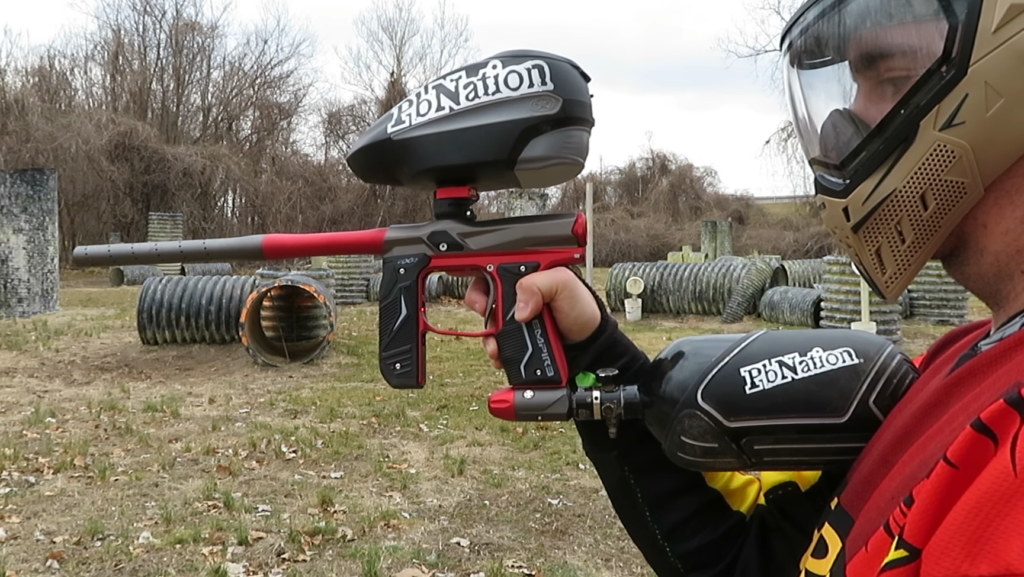
Chambers come in two basic types: break-action and blow-back. Break-action chambers have a removable breech plug that allows the player to manually load each paintball into the chamber before firing. Blow-back chambers have a small piston that pushes each paintball into the chamber as it is fired, making them semi-automatic or fully automatic.
The Barrel
Most barrels are made of metal or carbon fiber and range in length from eight to fourteen inches. The size and type of barrel you choose will have a significant impact on the performance of your gun.
For example, a longer barrel will provide greater accuracy but may be more difficult to maneuver in tight spaces. A shorter barrel will be easier to maneuver but may sacrifice some accuracy. The type of material your barrel is made of will also affect its performance. Carbon fiber barrels are typically lighter and more accurate than metal barrels, but they are also more expensive.
Paintball guns can vary significantly in price, from around $50 for a basic model to over $1000 for a high-end tournament-level gun. When choosing a paintball gun, it is important to consider the type of play you will be doing and your budget. If you are just starting out, it is probably not necessary to spend a lot of money on an expensive gun. However, if you plan on playing competitively, it may be worth investing in a higher-quality gun.
With the myriad of brands and models of paintball guns available, it’s pivotal that you understand what you’re looking for before buying. Talk to other players, read online reviews, and handle different guns to get a feel for what is available.
The Trigger
Most triggers are made of metal or plastic and are located at the front of the gun, just behind the barrel. The trigger typically has a small lever or switch that must be depressed in order to fire the gun.
Triggers can vary significantly in design, from simple single-stage triggers to complex multi-stage triggers with electronic sensors. The type of trigger you choose will largely be a matter of personal preference. Some players prefer simple triggers that are easy to pull, while others prefer complex triggers that offer greater control over rate of fire.
Paintball guns typically use one of two types of firing mechanisms: mechanical or electro-pneumatic. Mechanical markers use a spring-loaded mechanism to fire the paintball, while electro-pneumatic markers use a solenoid valve to release compressed air and fire the paintball.
Electro-pneumatic markers are generally more expensive than mechanical markers, but they offer a number of advantages, including higher rates of fire and greater accuracy. If you plan on playing competitively, an electro-pneumatic marker is probably the best choice. However, if you are just starting out or only playing recreationally, a mechanical marker may be all you need.
Paintball guns use compressed air or CO₂ to propel paintballs through the barrel and into your opponent. Compressed air is typically used for high-end markers, while CO₂ is more commonly used for entry-level markers.
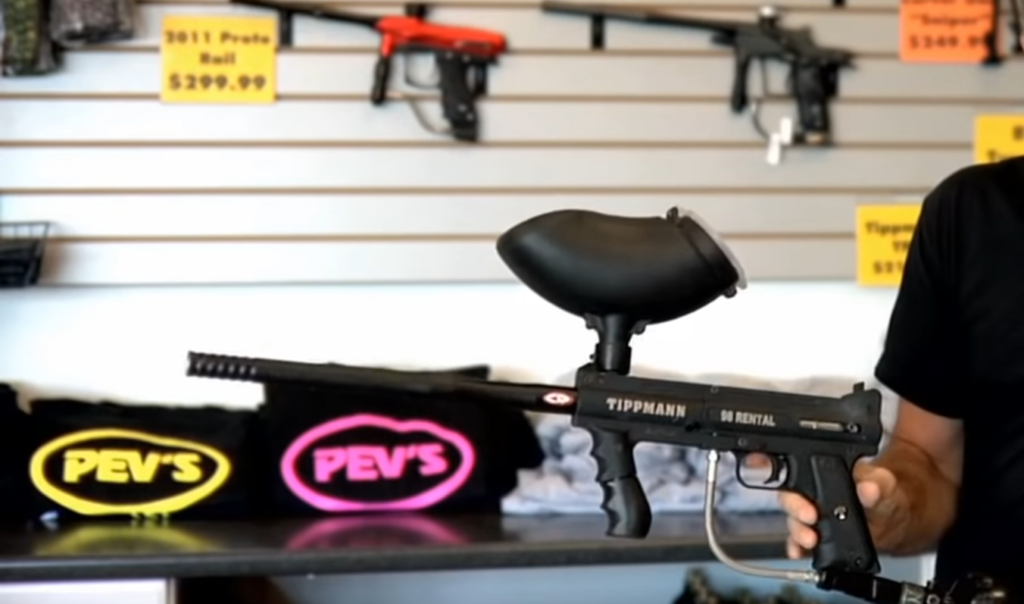
Compressed air is considered to be the better option because it provides consistent performance in all weather conditions and is less likely to damage your paintball gun. CO₂ is cheaper and easier to find, but it can freeze in cold weather and may cause your gun to malfunction if not used properly.
The Air Tank
The size of the tank will determine how many shots you can fire before needing to refill it. Most tanks hold between twenty and ninety pounds of pressure, although there are some larger tanks that can hold up to three hundred pounds of pressure.
Tanks can be either disposable or refillable. Disposable tanks are less expensive but need to be replaced when they are empty. Refillable tanks are more expensive but can be refilled at a local filling station.
It is important to choose an air tank that is compatible with your paintball gun. Most guns have specific requirements for the type and size of the tank they can use. Be sure to check the requirements for your gun before purchasing an air tank.
Paintball guns use compressed air or CO₂ to propel paintballs through the barrel and into your opponent. Compressed air is typically used for high-end markers, while CO₂ is more commonly used for entry-level markers.
Compressed air is considered to be the better option because it provides consistent performance in all weather conditions and is less likely to damage your paintball gun. CO₂ is cheaper and easier to find, but it can freeze in cold weather and may cause your gun to malfunction if not used properly.
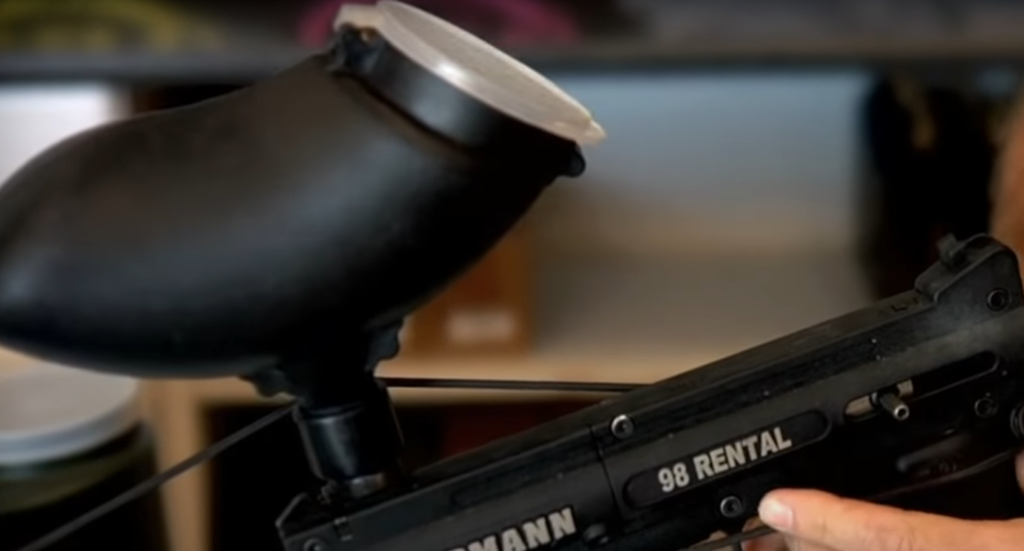
How Does a Paintball Gun Shoot a Ball?
The answer to this question is both simple and complex. In its simplest form, a paintball gun uses compressed gas—usually carbon dioxide (CO₂)—to push a paint-filled ball through a barrel and towards your opponent. However, the mechanics of how that works are a bit more complicated.
- Pump Paintball Guns: They are the most basic type of paintball gun. They require you to manually cock the gun before each shot by pumping a handle up and down. This action pressurizes the CO₂ tank and loads a paintball into the chamber.
- Semi-Automatic Paintball Guns: They are the most popular type of paintball gun. They have a mechanical device that automatically cocks the gun for you, so all you have to do is pull the trigger.
- Automatic Paintball Guns: They are similar to semi-automatic guns, but they can fire multiple shots in rapid succession without having to manually cock the gun each time.
Two Types of Markers
There are two types of markers: mechanical and electronic. Most entry-level markers are mechanical; they’re powered by a spring-loaded mechanism that’s cocked before each shot. When you pull the trigger, a sear releases the compressed spring, pushing a piston forward and propelling the paintball through the barrel.
Electronic markers, on the other hand, use an electric solenoid to release the compressed air or CO₂.
Paintballs are fed into the marker via a hopper, which is mounted on top of the gun. The hopper holds anywhere from 50 to 200+ paintballs and uses gravity to feed them into the marker.
When a paintball is fired, it travels through a short piece of tubing called an air hose and into the marker’s chamber. [4]
Paintballs are fairly fragile and will break if they hit something too hard, like a tree or another player’s mask. That’s why most players wear protective clothing, including a helmet with visor or goggles to protect their face, neck protector, gloves, long pants and shirt. Some players also wear knee and elbow pads.

Mechanical Paintball Guns
As mentioned earlier, mechanical paintball guns are powered by a spring-loaded mechanism. To cock the gun, you pull back on a handle (called a bolt) until it locks into place. This compresses a spring inside the marker.
Mechanical markers are generally less expensive than their electronic counterparts but they’re also less reliable and tend to have slower rates of fire. However, many experienced players prefer mechanical markers because they’re simpler and easier to maintain.
Electronic Paintball Guns
As we mentioned earlier, electronic paintball guns are powered by an electric solenoid. When you pull the trigger, it triggers the solenoid, which releases a burst of compressed air or CO₂ that propels the paintball through the barrel.
Electronic markers tend to be more expensive than their mechanical counterparts but offer some advantages, such as higher rates of fire and more consistent performance. However, they’re also more complex and can be difficult to troubleshoot if something goes wrong. [3]
If you’re just starting out, we recommend getting a mechanical marker. They’re more forgiving and will help you learn the basics of paintball without breaking the bank. However, if you’re dead-set on getting an electronic marker, make sure to do your research and buy from a reputable brand.
How Does a Paintball Gun Differ from a Normal Gun?
A paintball gun is designed to fire a small, round, gel-filled capsule that breaks upon impact and leaves a bright mark on its target. Paintball guns typically use compressed gas—such as carbon dioxide (CO₂) or nitrogen—to propel the paintball through the barrel of the gun at high speeds.
Paintball guns are also designed to be much safer than traditional firearms. For example, most paintball guns have barrels that are too small to allow a person to be shot in the eye from close range. Additionally, many commercial fields require players to use “barrel socks” or “barrel plugs” that cover the end of the barrel and prevent players from being shot in the face.
How Is a Pump Paintball Gun Different From Other Paintball Guns?
Pump paintball guns are different from other types of paintball guns in a few key ways. First, pump paintball guns must be cocked manually before each shot. This is done by either pulling back a lever on the gun (known as a bolt) or by pumping a handle up and down.
Second, pump paintball guns have fewer features than other types of paintball guns. For example, they may not have electronic trigger systems or sights. This makes them simpler to use and maintain, but also means that they may not perform as well in competitive play.
Finally, because of their design, pump paintball guns are often more affordable. This makes them a great option for beginner and casual players.
If you’re interested in trying out a pump paintball gun, we recommend checking out the products from Tippmann, Empire, and JT. These companies make high-quality, affordable pump paintball guns that are perfect for beginners and casual players.
The Best Way to Aim a Paintball
The best way to aim a paintball gun is by using the sites. Most paintball guns will come with sites, which are small red or green dots that you place on the top of the gun. These help you to line up your shot so that you can hit your target more easily. You should also make sure that you are holding the gun steady when you shoot, as this will give you a better chance of hitting your target. Finally, don’t forget to breathe! Taking a deep breath and exhaling slowly will help you to keep your hand steady and improve your accuracy.
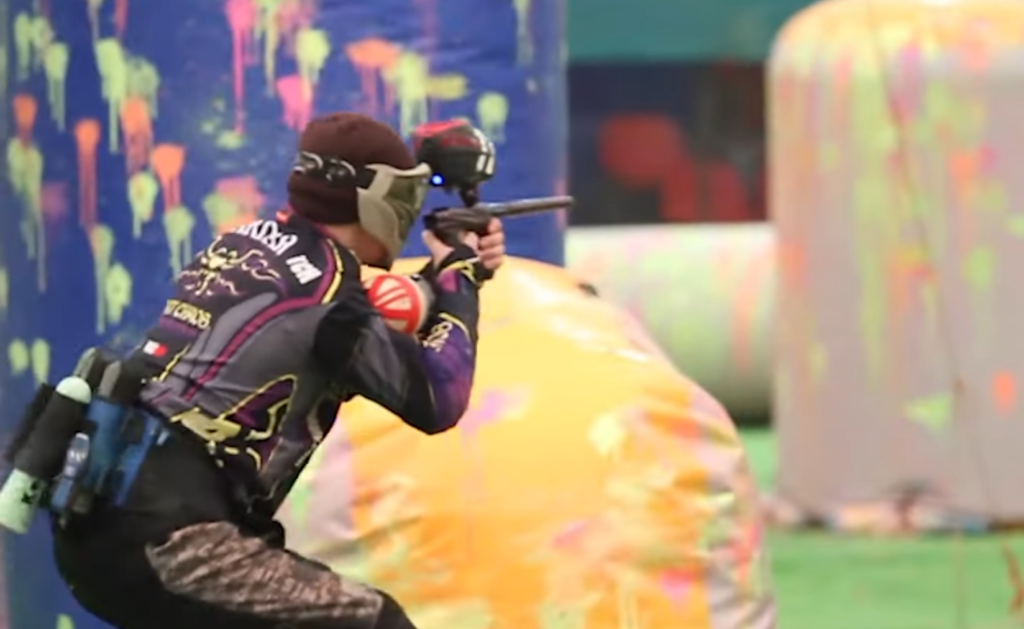
Paintball Gun Mechanism
Paintball guns, also called markers, are designed to shoot paint-filled balls through a barrel at high velocity. The sport of paintball has grown in popularity since its inception in the early 1980s. A paintball marker consists of three main components: an air source, a hopper or loader, and the marker itself.
The air source is typically a large tank of compressed CO₂ or nitrogen that attaches to the marker. Most recreational players use CO₂ tanks, while more serious players tend to prefer nitrogen tanks because they provide a consistent output of air pressure (essential for accuracy) and don’t get as cold when discharged.
Semi-Automatic Markers
The first type of paintball gun is the semi-automatic marker. These are the most popular guns on the market and are perfect for beginners and casual players. Semi-automatics use a hopper, which is a gravity-fed system that holds the paintballs. The hopper sits on top of the gun and feeds paintballs into the breech (barrel).
When you pull the trigger, a small amount of air is released from the tank and goes into the firing chamber. This propels the paintball through the barrel and into your opponent! Most semi-automatic markers can fire up to 15 balls per second.
One of the benefits of using a semi-automatic marker is that they’re easy to use and don’t require a lot of maintenance. Plus, they’re very affordable – you can find a good quality semi-automatic marker for under $200.
Paintball Shooting Safety
As with any kind of gun, there are safety risks involved in playing paintball. According to the National Paintball Fields Association, there are an average of 24 injuries per 100,000 players annually. Most of these injuries are minor, but serious ones can occur if players aren’t careful.
Here are some basic safety tips to keep in mind when playing paintball:
- Always wear protective gear, including a mask, gloves, and long sleeves.
- Don’t remove your mask while you’re on the field.
- Be aware of your surroundings and don’t shoot at people who aren’t wearing protective gear.
- Keep your finger off the trigger until you’re ready to shoot.
- Don’t shoot at close range. [5]
With these safety tips in mind, you’re ready to start playing paintball! Just remember to have fun and be safe.
FAQ
How does a paintball gun reload?
To reload a paintball gun, first remove the empty CO₂ canister from the gun. Next, screw in a new canister of CO₂. Finally, load fresh paintballs into the gun’s hopper.
Paintball guns use compressed air to shoot paintballs. The air is typically supplied by a small CO₂ canister that fits into the gun. To reload the gun, you simply need to remove the empty canister and screw in a new one. [6]
Does it hurt to get hit by a paintball gun?
This is probably the number one question people have about paintball. And the answer is… it depends. If you get hit in an unprotected area, like your face or fingers, it’s going to hurt a lot more than if you get hit in a padded area, like your stomach or back. That being said, even getting hit in a padded area is going to sting—think of it as getting slapped with a wet towel.
The best way to avoid getting hurt is to wear proper protective gear—a mask, gloves, and clothing that covers as much of your body as possible. And even with all that gear on, you should still be aware of where you’re standing in relation to other players. Getting hit by a paintball at close range is going to hurt, no matter what. [7]
One last thing to keep in mind is that paintballs are designed to break on impact, so they’re not going to do any lasting damage. The worst you can expect is a bruise, which will fade after a few days. So if you’re thinking about getting into paintball, don’t let the fear of getting hurt stop you—it’s all part of the fun!
What holds the paintballs on a paintball gun?
The hopper is the plastic container that sits on top of the paintball gun and holds the paintballs. It typically has a capacity of around 200 paintballs. The hopper is gravity-fed, meaning that the paintballs are dropped into it from above and then fed into the gun one at a time.
There are also electronic hoppers that use sensors and motors to agitate the paintballs and keep them from clogging up. These types of hoppers can fire much faster than gravity-fed hoppers, but they’re also more expensive.
How is a paintball gun powered?
Paintball guns are powered in a variety of ways, the most common being CO₂. Tanks of compressed CO₂ are attached to the gun and when the trigger is pulled, a small amount of CO₂ is released into the gun chamber. This propels the paintball through the barrel and towards your target.
Another popular method is using high-pressure air tanks. These work in a similar way to CO₂ tanks but use compressed air instead. The advantage of using an air tank is that they don’t experience temperature changes like CO₂ tanks, meaning your paintballs are less likely to break inside the gun barrel.
Useful Video: How to Use a Paintball Gun aka Marker | Paintball
Conclusion
Paintball is a sport that can be enjoyed by people of all ages. It’s a great way to get some exercise while also having a lot of fun. If you’re thinking about getting into paintball, or are just curious about how it works, then this guide is for you.
Now get out there and start playing! Just remember to always stay safe and have fun. Thanks for reading! Happy painting!
References
- https://hobbystrategy.com/how-do-pump-paintball-guns-work/
- https://entertainment.howstuffworks.com/paintball.htm
- https://www.liveabout.com/how-far-can-a-paintball-gun-shoot-2565810
- https://www.bzpaintball.co.uk/blog/post/electronic-vs-mechanical-markers
- https://www.mayhempaintball.co.uk/about/is-paintball-safe
- https://www.valken.com/blog-entries/how-to-load-a-paintball-gun
- https://www.liveabout.com/does-it-hurt-to-get-hit-by-a-paintball-2565740


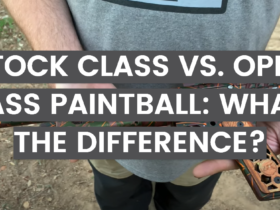



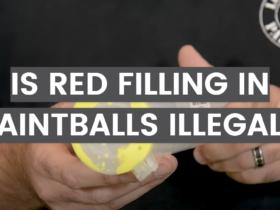

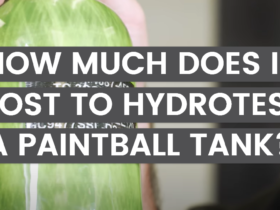
Leave a Review